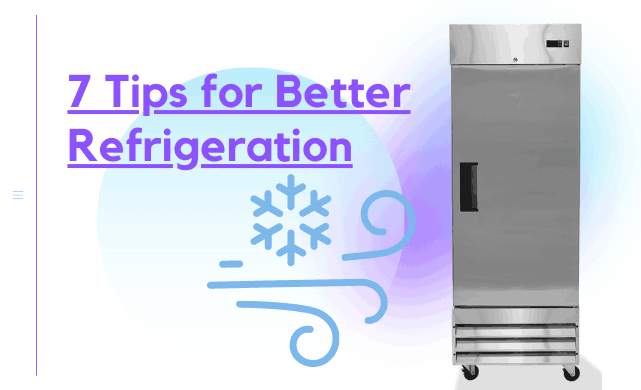7 Tips for Better Refrigeration
Nearly all foodservice operations, from the corner restaurant to the school cafeteria, have a variety of refrigeration equipment; including refrigerators, freezers and walk-in coolers, to store inventory safely until it is served. Taking steps to make sure your refrigerators and freezers are operating efficiently and effectively can help you save money on energy costs and prevent a break-down that may include both a costly repair bill and expensive loss in food inventory.
Here are seven tips to follow for better refrigeration and to reduce the chances of a costly mechanical mishap.
1. Always turn off the power of your refrigerator or freezer before leaving the door open to load or clean the unit. If an employee props the door open for an extended period of time for any reason, can cause the condenser to ice up causing operational problems. Once the unit is loaded or cleaned and the door is closed, plug the unit back in and check to make sure that it returns to the correct temperature.
2. Do not allow anyone to lower the thermostat below the recommended temperature settings. Most commercial refrigerators are recommended to be set at 38 degrees Fahrenheit so that food in the unit is at a safe temperature at 40 degrees Fahrenheit or below.
3. Cool hot items before placing them in the refrigerator. This has a double benefit. First, placing hot foods in your refrigerator will make the unit work extra in order to both cool the food and bring the entire unit back down to the base line so cooling foods first saves energy. Additionally, because the placement of a large amount of hot food will elevate the interior temperature of the unit, you risk all the foods in the unit going outside safe temperature zones.
4. Use several trays to store stock inside your refrigerator. This will allow cold air to circulate well over the product. We recommend utilizing food pans that are 4†deep or less so food chills faster.
5. Cover acidic foods like tomatoes, onions or foods with a vinegar sauce. The acid from these foods can circulate through the refrigerator cabinet, settling on the coils causing deterioration.
6. Check the way your refrigerator or freezer is loaded and make sure that air circulation within the unit is not blocked in any way. Often units get loaded by multiple employees and end up in disorder, so this should be checked regularly.
7. Be sure to position your refrigerator away from any equipment that is a heat source such as an oven, tilt skillet, griddle or grill. If ambient temperatures are higher than normal, your refrigeration units will have to work that much harder to achieve and maintain food safe temperatures.

Keywords: Refrigeration Tips
Moulded Rubber Parts,Engine Mounting Cushion,Car Engine Mount,Truck Engine Mounting
HE BEI HONGAN AUTOMOBILE AND MOTORCYCLE FITTINGS CO.,LTD , https://www.honganproduct.com




